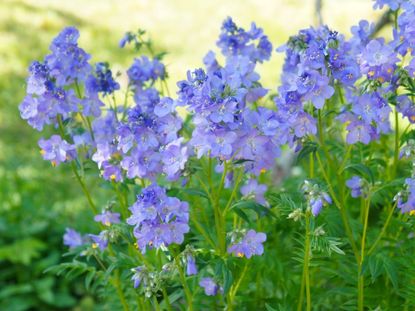Growing Jacob's Ladder - How To Grow And Plant Jacob's Ladder


There are two species of Jacob's ladder plant that are commonly found in the garden. The first, Polemonium reptans, is native to the northeastern quadrant of the United States and is considered a threatened species in some states.
Environmental care of Jacob's ladder includes discouraging gardeners from taking plants from the wild for transplant. Instead, try growing Jacob's ladder Polemonium caeruleum, the species developed for the garden, which is rarely found growing in the wild.
Jacob's Ladder Plant Info
One of the best features of the Jacob's ladder plant is its foliage. The plant forms a clump of densely packed leaf stems each bearing tiny leaflets, almost fern-like in appearance, that rise along the stem like the ladder of the Biblical dream of Jacob. This ladder formation is known as pinnate.
Each plant grows from 1 to 3 feet (31-91 cm.) high with a spread of 1 1/2 to 2 feet (46-61 cm.) wide. Loose clusters of flowers hang like bells from the long stems and come in white, pink, blue, or yellow depending on the cultivar. Once established, growing Jacob's ladder requires very little except for occasional trimming.
Jacob's ladder plants are, therefore, an excellent addition to the low maintenance garden.
How to Grow and Plant Jacob's Ladder
As always, before we talk about how to grow and plant Jacob's ladder, we need to look at the conditions it naturally prefers. The Jacob's ladder plant is a woodland perennial that prefers a shady to semi-shady spot for growing. Jacob's ladder leaves tend to scorch with too much heat or sun.
It grows best in soils that are rich in organic materials and likes a moist, but not soggy environment. That being said, one of the pleasures of this garden addition is that it tolerates drought once its root system is firmly entrenched. It is also deer resistant and isn't prone to disease or insect infestation.
Gardening tips, videos, info and more delivered right to your inbox!
Sign up for the Gardening Know How newsletter today and receive a free download of our most popular eBook "How to Grow Delicious Tomatoes."
Nothing is easier than how to grow and plant Jacob's ladder. Once you've located a spot suitable to their needs, there are two methods of propagation: by seed or by plant division.
- Seeds - Cultivars won't always breed true from seed, but if you're not concerned with specific colors, seeds (either purchased or self-sown) can yield some interesting results. Sow the tiny brown seeds directly into the soil in spring after all danger of frost has passed. Loosely cover the seeds with a fine sprinkling of soil, water gently, and keep moist until seedlings sprout. The seeds will germinate quickly and should be thinned to about 18 inches (46 cm.) apart. You'll get a fine showing of foliage the first year but may not see flowers until the second season.
- Divisions - For the best results and care of Jacob's ladder, divisions should be made in the early spring just as new growth appears. Carefully dig the entire plant from the ground. Separate the basal rosettes by tearing apart the roots and replant each of the resulting Jacob's ladder plants in its new spot. This is also a great time to replenish that area of the garden with rich, organic soil. Water your transplants well and keep the ground moist for a few weeks to give the plant's roots time to settle into their new home.
Care of Jacob's Ladder
These plants require minimal maintenance. After blooming, they can become leggy and need trimming. Jacob's ladder plants will rebloom if the flower stems are cut back to the base. Sometimes, especially in older plants, the foliage can become brown and tattered looking.
Trim out all unsightly foliage and new growth will begin almost immediately. Trimming Jacob's ladder plants and the occasional foliar feeding is all that's needed for the yearly care of Jacob's ladder in the garden.

Jackie Rhoades began writing for Gardening Know How in 2010.
-
 Does Gardening Reduce Carbon Footprint Size?
Does Gardening Reduce Carbon Footprint Size?If you’d like to learn how to reduce your carbon footprint on the Earth, start with your garden activities and planting decisions.
By Bonnie L. Grant
-
 How To Use Less Plastic: 5 Ways To Go Greener In Your Garden
How To Use Less Plastic: 5 Ways To Go Greener In Your GardenData on how our overuse of plastic is harming the planet may leave you wondering how to use less plastic. Here are ideas for reduced plastic use in the garden.
By Teo Spengler